

Compact Muon Solenoid
LHC, CERN
| CMS-PAS-SMP-19-014 | ||
| Observation of heavy triboson production in leptonic final states in proton-proton collisions at √s= 13 TeV | ||
| CMS Collaboration | ||
| Avril 2020 | ||
| Abstract: An observation of the combined production of three massive vector bosons (VVV with V = W, Z) in proton-proton collisions at a center-of-mass energy of 13 TeV is reported. The analysis is based on a data sample recorded by the CMS experiment at the CERN LHC corresponding to a total integrated luminosity of 137 fb−1. The searches for individual WWW, WWZ, WZZ, and ZZZ production processes are performed in final states with three, four, five, and six leptons (electrons or muons), or with two same-charge leptons plus one or two jets. The observed (expected) significance of the combined VVV production signal is 5.7 (5.9) standard deviations (sd) and the corresponding measured signal strength is 1.02+0.26−0.23. The significances of the individual WWW and WWZ channels are 3.3 and 3.4 sd, respectively. The measured production cross sections for the individual triboson final states are also reported. | ||
|
Links:
CDS record (PDF) ;
CADI line (restricted) ;
These preliminary results are superseded in this paper, PRL 125 (2020) 151802. The superseded preliminary plots can be found here. |
||
| Figures & Tables | Summary | Additional Figures & Tables | References | CMS Publications |
|---|
| Figures | |
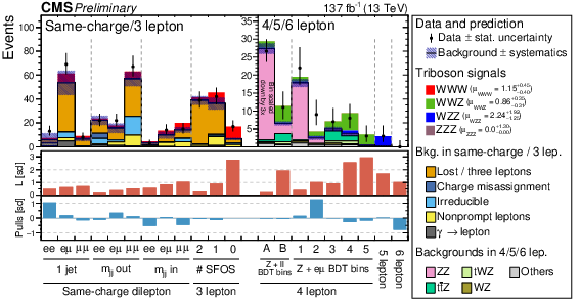
png pdf |
Figure 1:
Comparison of the observed numbers of events from the BDT-based selections to the predicted yields after fitting. The VVV signal is shown stacked on top of the total background and is based on theoretical SM cross sections. The expected significance L in the middle panel represents the number of sd with which the null hypothesis (no signal) is rejected. The lower panel shows the pulls for the fit result. |

png pdf |
Figure 2:
Best fit values of the signal strengths for the BDT-based analyses (blue) and the sequential-cut analyses (black). For ZZZ production, a 95% CL upper limit is shown. The stated numerical values correspond to the BDT-based analysis. |
| Tables | |
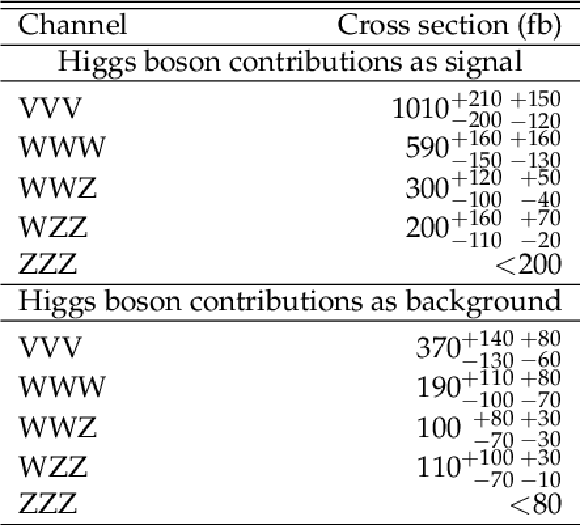
png pdf |
Table 1:
Measured cross sections obtained with the BDT-based analyses. The uncertainties listed are statistical and systematic. The VVV cross section is calculated from the fit for μcomb. For the ZZZ channel, 95% confidence level upper limits are reported. |
| Summary |
| In summary, data recorded with the CMS experiment during the LHC Run~2 amounting to 137 fb−1 of pp collisions at √s= 13 TeV were used to search for the production of triple heavy gauge bosons observed in leptonic final states. The significance of the observation is 5.7 standard deviations (sd) with 5.9 sd expected. For WWW (WWZ) production, the observed significance is 3.3 sd (3.4 sd) compatible with 3.1 sd (4.1 sd) expected. Measured cross sections for individual production processes for WWW, WWZ, and WZZ and an upper limit for ZZZ were reported and are in agreement with the expectations of the standard model. This note documents the first evidence for WWW and WWZ production and the first observation of the combined heavy triboson production by the CMS Collaboration. |
| Additional Figures | |

png pdf |
Additional Figure 1:
Distribution of the dijet invariant mass, mjj, for events with two same-charged leptons (e or μ) and at least two jets for data and simulation corresponding to 137 fb−1. The VVV signal is stacked on top of the background. The uncertainties shown are only statistical. |
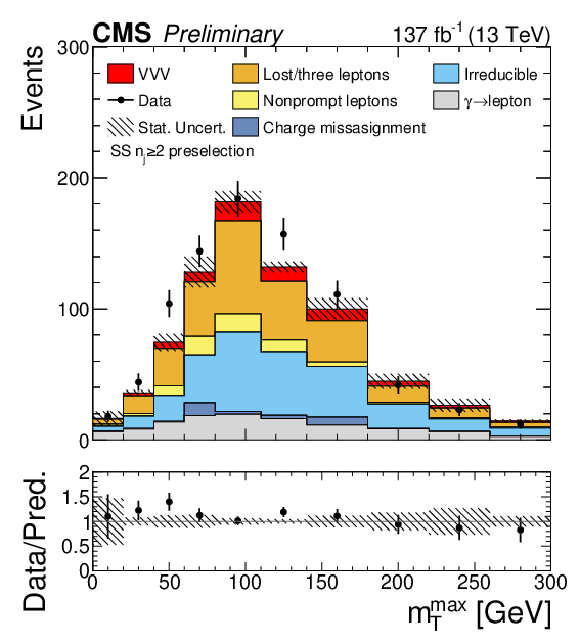
png pdf |
Additional Figure 2:
Distribution of the maximal transverse mass, mTmax, for events with two same-charged leptons (e or μ) and at least two jets for data and simulation corresponding to 137 fb−1. The VVV signal is stacked on top of the background. The uncertainties shown are only statistical. |
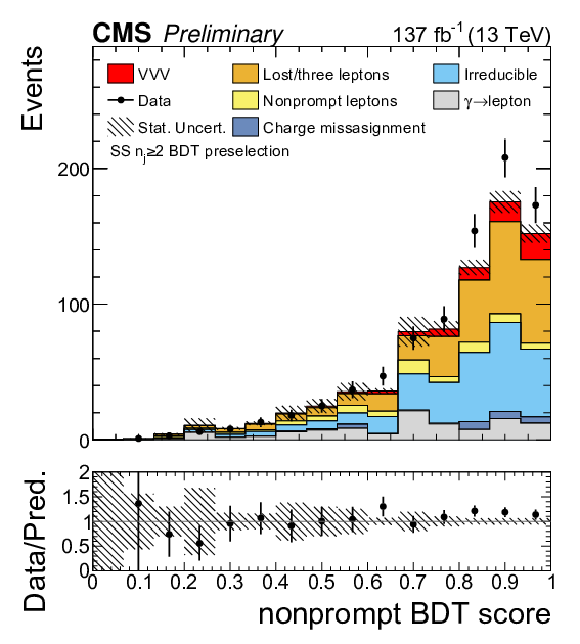
png pdf |
Additional Figure 3:
Distribution of the nonprompt lepton-BDT score for events with two same-charged leptons (e or μ) and at least two jets for data and simulation corresponding to 137 fb−1. The VVV signal is stacked on top of the background. The uncertainties shown are only statistical. |
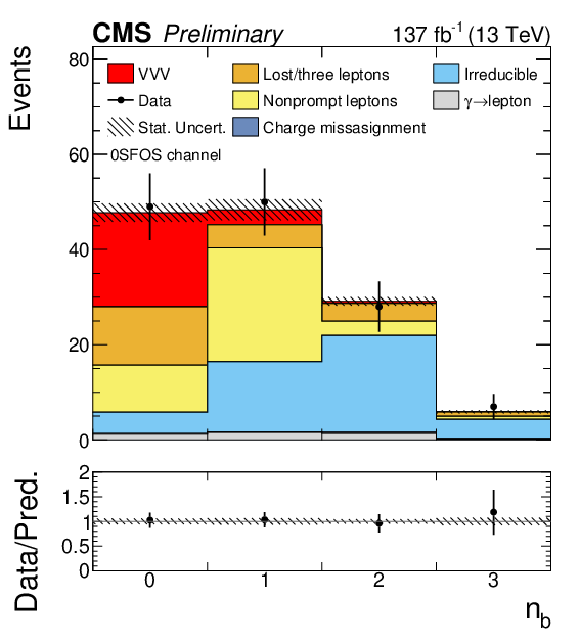
png pdf |
Additional Figure 4:
Distribution of the number of b-tagged jets, nb, for events with three charged leptons (e or μ) with no same-flavor opposite-charged lepton pair (0 SFOS) for data and simulation corresponding to 137 fb−1. The VVV signal is stacked on top of the background. The uncertainties shown are only statistical. |
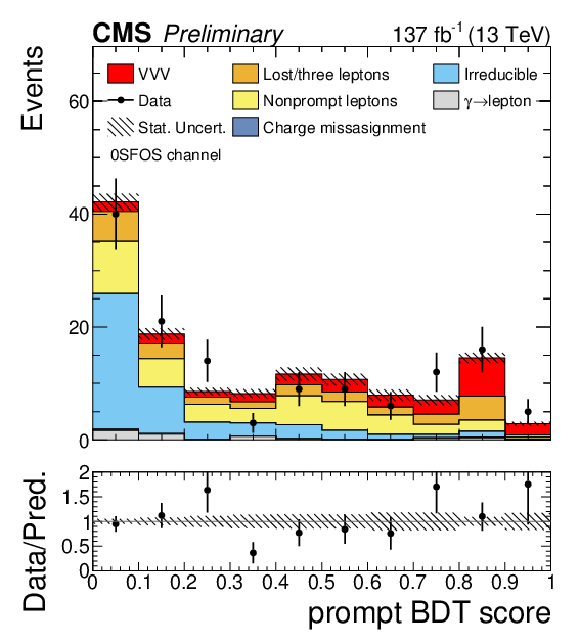
png pdf |
Additional Figure 5:
Distribution of the prompt lepton-BDT score for events with three charged leptons (e or μ) with no same-flavor opposite-charged lepton pair (0 SFOS) for data and simulation corresponding to 137 fb−1. The VVV signal is stacked on top of the background. The uncertainties shown are only statistical. |
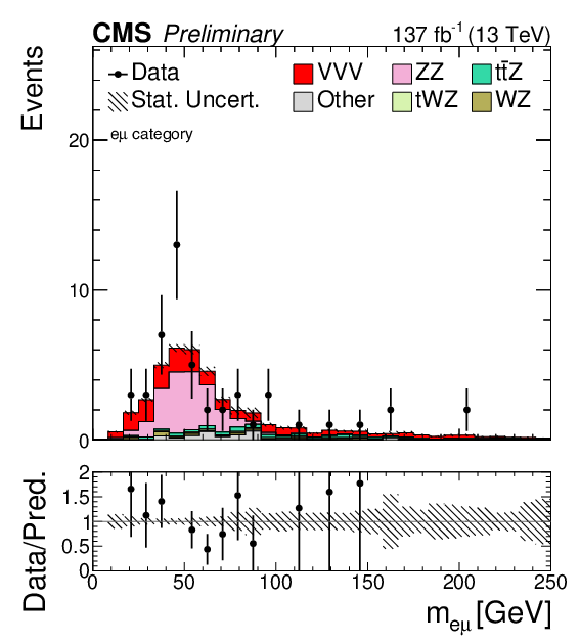
png pdf |
Additional Figure 6:
Distribution of the invariant mass of the two leptons not forming a Z boson candidate, meμ, for events with four charged leptons (e or μ) in the eμ category for data and simulation corresponding to 137 fb−1. The VVV signal is stacked on top of the background. The uncertainties shown are only statistical. |

png pdf |
Additional Figure 7:
Distribution of mT2 for events with four charged leptons (e or μ) in the eμ category for data and simulation corresponding to 137 fb−1. The VVV signal is stacked on top of the background. The uncertainties shown are only statistical. |
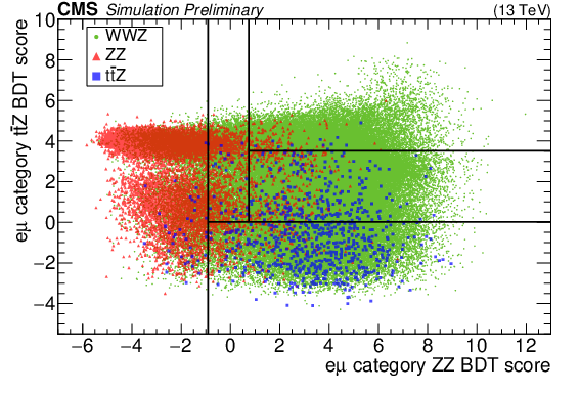
png pdf |
Additional Figure 8:
Distribution of the BDT score of the ZZ and t¯tZ BDT for events with four charged leptons (e or μ) in the eμ category for simulation for WWZ, ZZ, and t¯tZ events. |

png pdf |
Additional Figure 9:
Distribution of the missing transverse momentum, pTmiss, for events with four charged leptons (e or μ) in the ee/μμ category for data and simulation corresponding to 137 fb−1. The VVV signal is stacked on top of the background. The uncertainties shown are only statistical. |
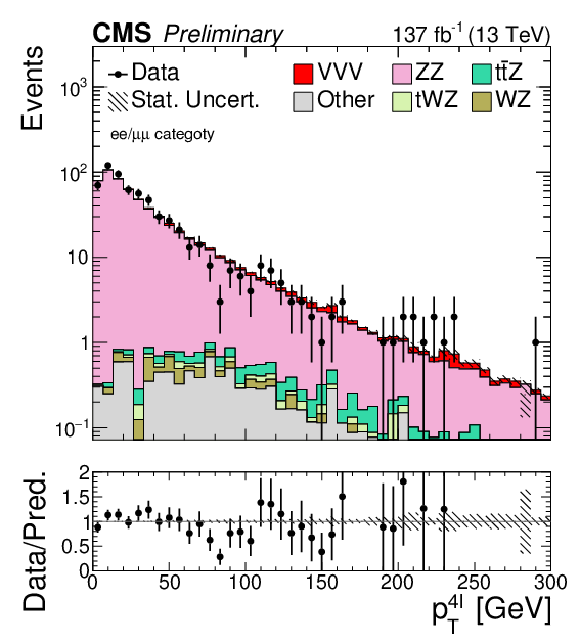
png pdf |
Additional Figure 10:
Distribution of transverse momentum of the four-lepton system, pT4ℓ, for events with four charged leptons (e or μ) in the ee/μμ category for data and simulation corresponding to 137 fb−1. The VVV signal is stacked on top of the background. The uncertainties shown are only statistical. |
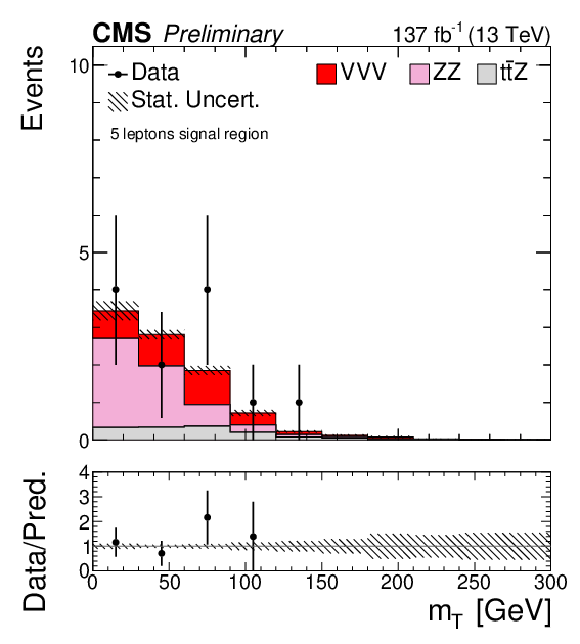
png pdf |
Additional Figure 11:
Distribution of transverse mass, mT, of the lepton assigned as W boson candidate and the pTmiss for events with five charged leptons (e or μ) for data and simulation corresponding to 137 fb−1. The VVV signal is stacked on top of the background. |
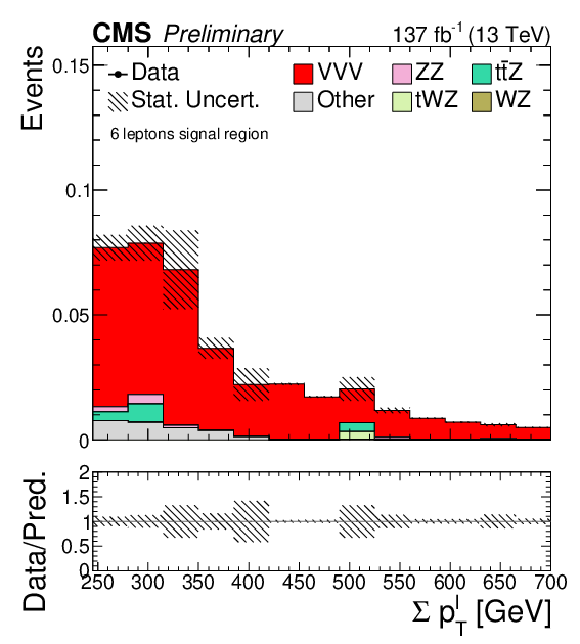
png pdf |
Additional Figure 12:
Distribution of the scalar sum of the lepton transverse momenta, ∑pTℓ, for events with at least six charged leptons (e or μ) for data and simulation corresponding to 137 fb−1 in the six lepton signal region. The VVV signal is stacked on top of the background. The uncertainties shown are only statistical. |
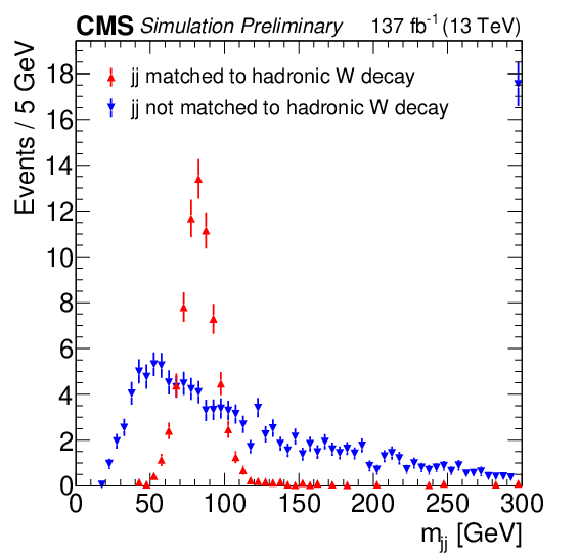
png pdf |
Additional Figure 13:
Distribution of the dijet invariant mass, mjj, for events with two same-charged leptons (e or μ) and at least two jets for the WWW signal simulation. The signal events are seperated into a category where the two jets are matched to a quark from the W boson decay (red), and another category for all other events. The uncertainties shown are only statistical. |

png pdf |
Additional Figure 14:
Distribution of the subleading parton transverse momentum for a quark from the W boson decay for the WWW signal simulation. The signal events are seperated into a category where all W bosons were generated onshell, and a category of WH→WWW. |

png pdf |
Additional Figure 15:
Distribution of the dijet invariant mass, mjj, for events with two same-charged leptons (e or μ) and at least two jets in the lost-lepton control region for data and simulation corresponding to 137 fb−1. The uncertainties shown are only statistical. |
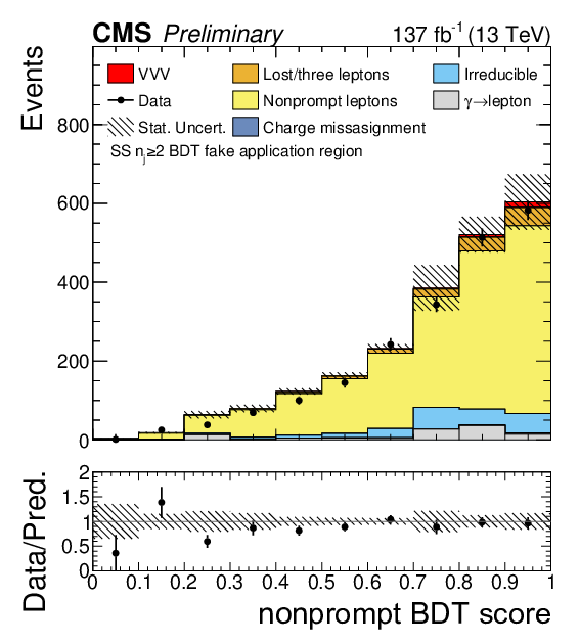
png pdf |
Additional Figure 16:
Distribution of the nonprompt lepton BDT score for events with three charged leptons (e or μ) with no same-flavor opposite-charged lepton pair (0 SFOS) in the loose-lepton control region for data and simulation corresponding to 137 fb−1. The uncertainties shown are only statistical. |
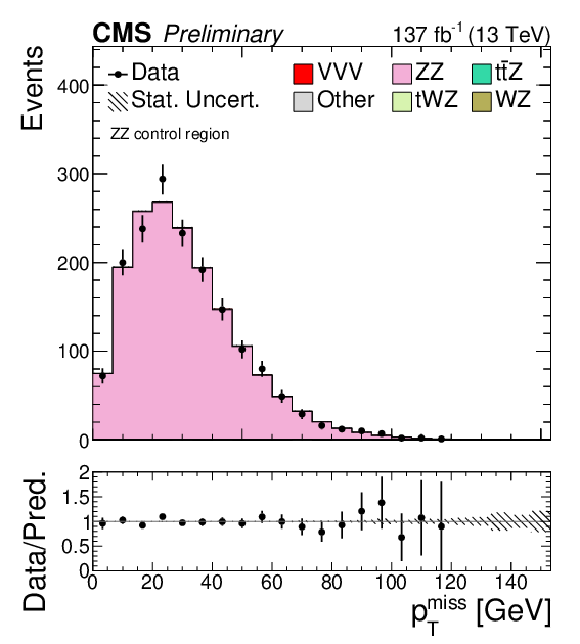
png pdf |
Additional Figure 17:
Distribution of the missing transverse momentum, pTmiss, for events with four charged leptons (e or μ) in the ZZ control region for data and simulation corresponding to 137 fb−1. The uncertainties shown are only statistical. |
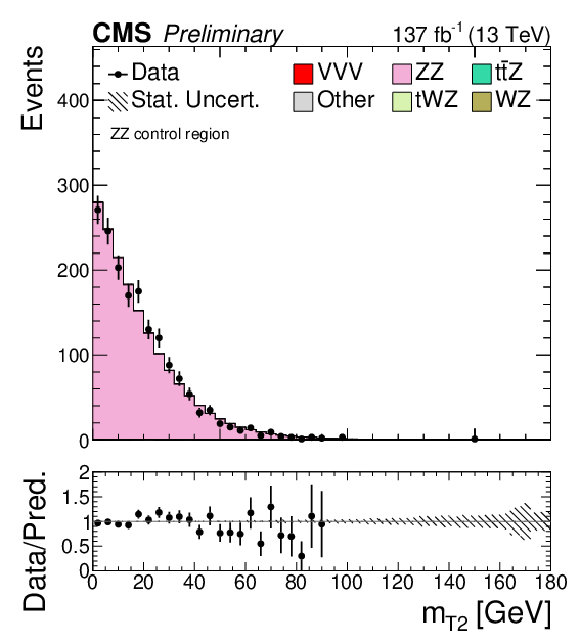
png pdf |
Additional Figure 18:
Distribution of mT2 for events with four charged leptons (e or μ) in the ZZ control region for data and simulation corresponding to 137 fb−1. The uncertainties shown are only statistical. |
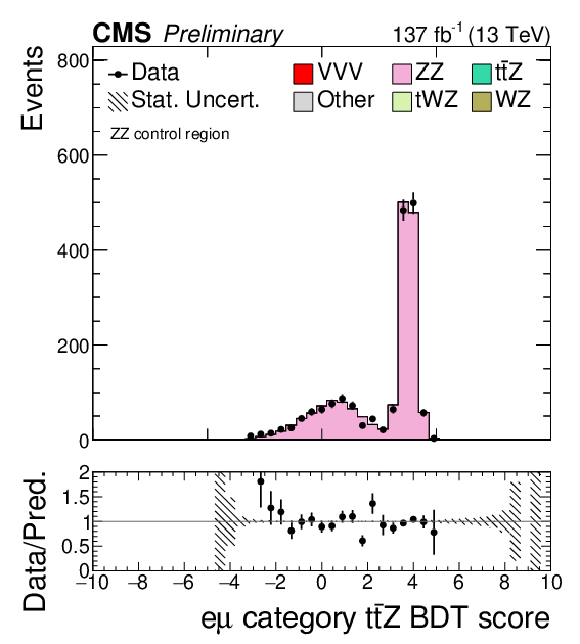
png pdf |
Additional Figure 19:
Distribution of the BDT score of the t¯tZ BDT for events with four charged leptons (e or μ) in the ZZ control region for data and simulation corresponding to 137 fb−1. The uncertainties shown are only statistical. |
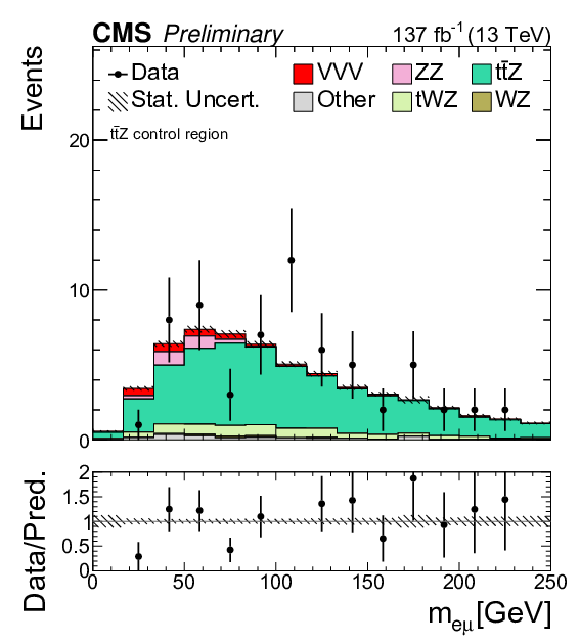
png pdf |
Additional Figure 20:
Distribution of the invariant mass of the two leptons not forming a Z boson candidate, meμ, for events with four charged leptons (e or μ) in the t¯tZ control region for data and simulation corresponding to 137 fb−1. The uncertainties shown are only statistical. |
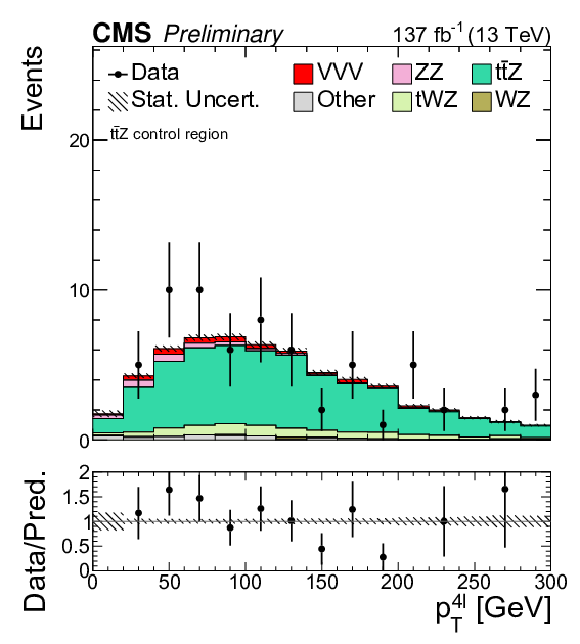
png pdf |
Additional Figure 21:
Distribution of the transverse momentum of the four-lepton system, pT4ℓ, for events with four charged leptons (e or μ) in the t¯tZ control region for data and simulation corresponding to 137 fb−1. The uncertainties shown are only statistical. |

png pdf |
Additional Figure 22:
Distribution of the BDT score of the ZZ BDT for events with four charged leptons (e or μ) in the t¯tZ control region for data and simulation corresponding to 137 fb−1. The uncertainties shown are only statistical. |
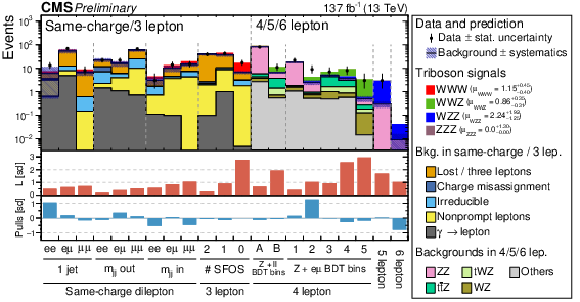
png pdf |
Additional Figure 23:
Comparison of the observed numbers of events from the BDT-based selections to the predicted yields after fitting. The VVV signal is shown stacked on top of the total background and is based on theoretical SM cross sections times the signal strengths shown in the legend. The significance L in the middle panel represents the expected number of sd with which the null hypothesis (no signal) is rejected. The lower panel shows the pulls for the fit result. |
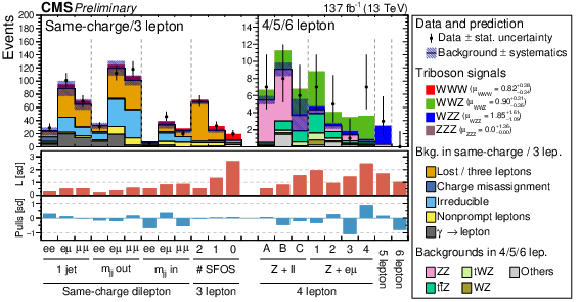
png pdf |
Additional Figure 24:
Comparison of the observed numbers of events from the sequential-cut selections to the predicted yields after fitting. The VVV signal is shown stacked on top of the total background and is based on theoretical SM cross sections times the signal strengths shown in the legend. The significance L in the middle panel represents the expected number of sd with which the null hypothesis (no signal) is rejected. The lower panel shows the pulls for the fit result. |
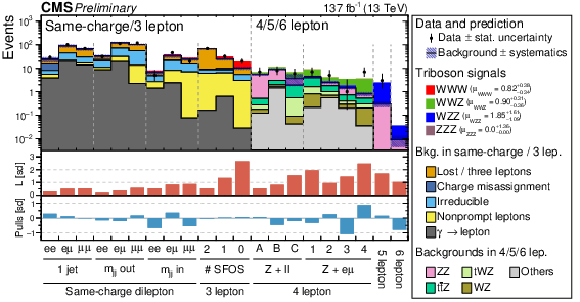
png pdf |
Additional Figure 25:
Comparison of the observed numbers of events from the sequential-cut selections to the predicted yields after fitting. The VVV signal is shown stacked on top of the total background and is based on theoretical SM cross sections times the signal strengths shown in the legend. The significance L in the middle panel represents the expected number of sd with which the null hypothesis (no signal) is rejected. The lower panel shows the pulls for the fit result. |
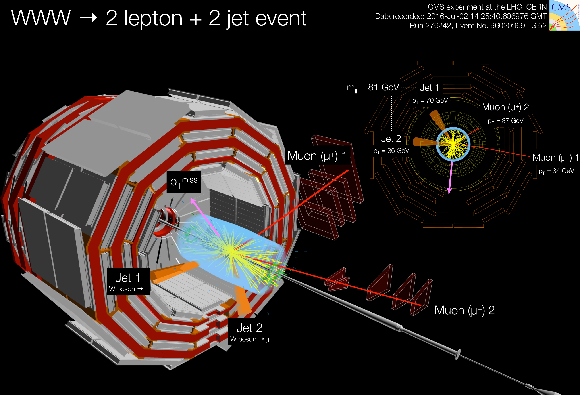
png pdf |
Additional Figure 26:
Event display of candidate WWW event in same-sign dilepton plus two jets final states. In this event, there are two positively charged muons (red) along with two jets (orange cones) with an invariant mass consistent with the W mass. The neutrinos are represented by pTmiss (pink arrow). The tracks reconstructed in the event are represented by the yellow trajectories. The CMS detector depicted in the figure shows the muon system from one side of the hemisphere. The rest of the detector components are omitted for illustration purpose. The corresponding muon chambers that detected the muons in the event are depicted. The beam pipe can be seen in the center where the two proton beams approach from each side. On the right, the transverse view of the same event is shown. |
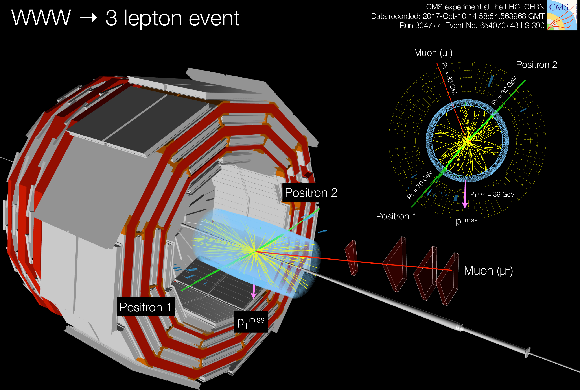
png pdf |
Additional Figure 27:
Event display of candidate WWW event in three lepton final states. In this event, there are two positrons and one muon where no pair of leptons consist an oppositely charged same flavor dilepton pair. The green tracks are the tracks from the positrons, and the green towers represent the electromagnetic calorimeter energy deposits from the positrons. The neutrinos are represented by pTmiss (pink arrow). The tracks reconstructed in the event are represented by the yellow trajectories. The CMS detector depicted in the figure shows the muon system from one side of the hemisphere. The rest of the detector components are omitted for illustration purpose. The corresponding muon chambers that detected the muons in the event are depicted. The beam pipe can be seen in the center where the two proton beams approach from each side. On the right, the transverse view of the same event is shown. |
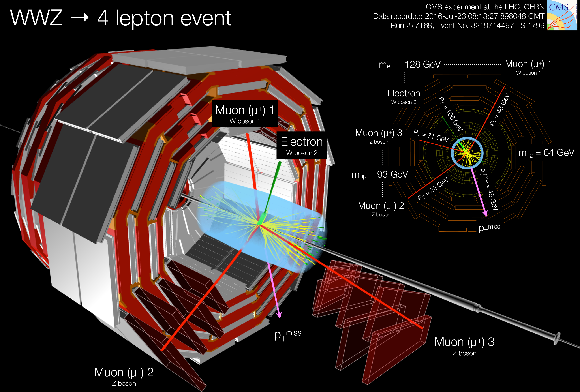
png pdf |
Additional Figure 28:
Event display of candidate WWZ event in four lepton final states. In this event, there is a pair of oppositely charged muons (red) with an invariant mass consistent with the Z mass. There is an additional oppositely charged eμ pair in the event as well. The green track is the track from the electron in the event. The green towers represent the electromagnetic calorimeter energy deposits from the positrons. The neutrinos are represented by pTmiss (pink arrow). The tracks reconstructed in the event are represented by the yellow trajectories. The mT2 computed from the eμ system and the pTmiss is 64 GeV and the invariant mass of the eμ system is 128 GeV. The CMS detector depicted in the figure shows the muon system from one side of the hemisphere. The rest of the detector components are omitted for illustration purpose. The corresponding muon chambers that detected the muons in the event are depicted. The beam pipe can be seen in the center where the two proton beams approach from each side. On the right, the transverse view of the same event is shown. |

png pdf |
Additional Figure 29:
Event display of candidate WZZ event in five lepton final states. Tracks from the positrons and electrons in the event are represented by green tracks. The green tower represents the electromagnetic calorimeter energy deposits from the positrons or electrons. In this event, there are two pairs of oppositely charged electrons with their invariant masses consistent with Z mass. The neutrino in the event is represented by pTmiss (pink arrow). In addition there is an extra electron in the event. The mT of the fifth electron and the pTmiss system is 65 GeV. |
| Additional Tables | |

png pdf |
Additional Table 1:
Event selection for the SS channel for the sequential-cut analysis: for each category (mjj-in, mjj-out, and 1j) we define three signal regions depending on the lepton flavor: e±e±, e±μ±, and μ±μ±. This results in 3×3=9 signal region for the SS channel. |
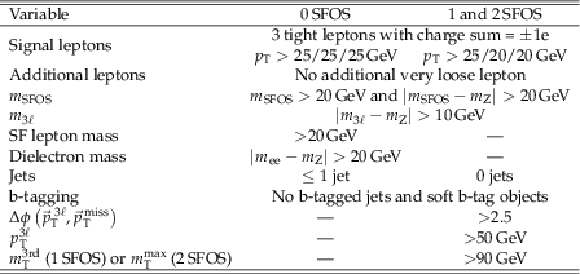
png pdf |
Additional Table 2:
Event selection for the 3ℓ channel for the sequential-cut analysis: We define 3 signal regions depending on the number of SFOS lepton pairs: 0, 1, or 2 SFOS. |
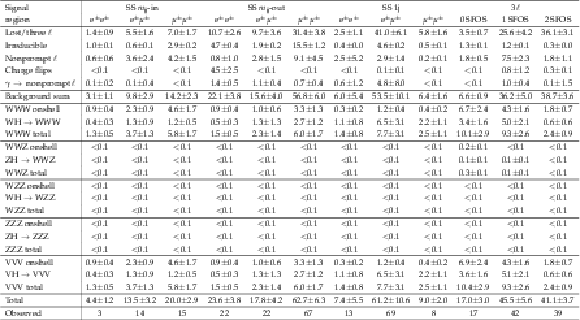
png pdf |
Additional Table 3:
Comparison of the observed numbers of events to the predicted yields after fitting of the BDT-based selections for the SS and 3ℓ final states. The VVV signal is shown both as a sum as well as separated into different production modes based on theoretical standard model cross sections. |

png pdf |
Additional Table 4:
Comparison of the observed numbers of events to the predicted yields after fitting of the BDT-based selection for the 4ℓ final state and the sequential-cut selections for the ≥5ℓ final states. The VVV signal is shown both as a sum as well as separated into different production modes based on theoretical standard model cross sections. The signal regions in the 4ℓ final state are defined through orthogonal selections in the two-dimensional plane of the ZZ and t¯tZ BDT scores. |
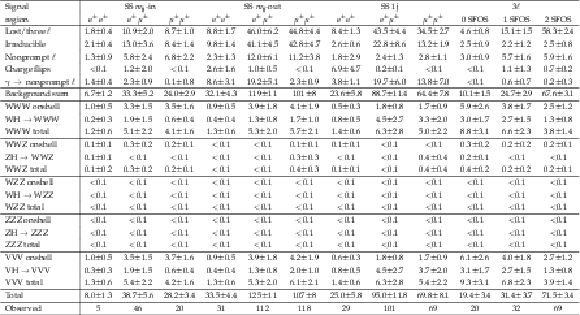
png pdf |
Additional Table 5:
Comparison of the observed numbers of events to the predicted yields after fitting of the sequential-cut selections for the SS and 3ℓ final states. The VVV signal is shown both as a sum as well as separated into different production modes based on theoretical standard model cross sections. |
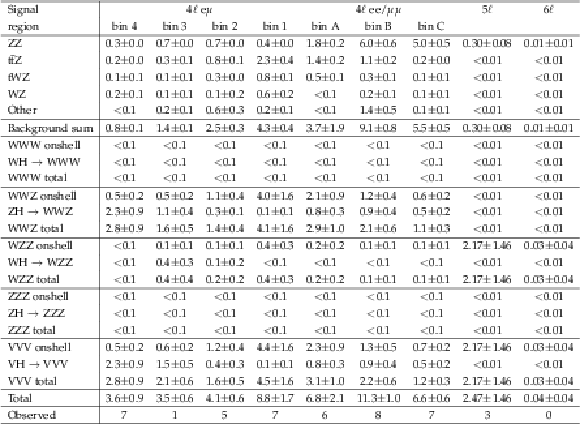
png pdf |
Additional Table 6:
Comparison of the observed numbers of events to the predicted yields after fitting of the sequential-cut selections for the ≥4ℓ final states. The VVV signal is shown both as a sum as well as separated into different production modes based on theoretical standard model cross sections. The signal regions in the eμ category are defined as (bins 1-4) meμ= 0-40, 40-60, 60-100, and ≥ 100 GeV. For events with meμ< 100 GeV, we require mT2> 25 GeV. The signal regions in the ee/μμ category are defined as pTmiss≥ 120 GeV (bin A) or 70 ≤pTmiss< 120 GeV and pT4ℓ≥ 70 GeV (bin B) or 40 ≤pT4ℓ< 70 GeV (bin C). |

png pdf |
Additional Table 7:
Values of the observed (expected) significances (in sd) with respect to the SM background-only hypothesis for the production of three massive vector bosons. When obtaining the significances of the individual processes, the four processes (WWW, WWZ, WZZ, and ZZZ) are fitted simultaneously. When obtaining the combined significances (VVV), all processes are treated to have relative cross sections as according to the standard model. |

png pdf |
Additional Table 8:
Values of the observed (expected) upper limits at 95% confidence on the signal strengths of the WZZ and ZZZ processes. The signal strength is defined as the measured cross section divided by the theoretical cross section. As the processes are fitted together with the WWW and WZZ processes that dominate the ≤4ℓ final states, different values for the sequential-cut and BDT-based analyses are obtained, even though fpr the ≥4ℓ final states we apply only sequential-cut selections. |
| References | ||||
| 1 | P. Langacker | Tests of the standard model and searches for new physics | Adv. Ser. Direct. High Energy Phys. 14 (1995) 883 | hep-ph/9412361 |
| 2 | G. Belanger and F. Boudjema | Probing quartic couplings of weak bosons through three vectors production at a 500-GeV NLC | PLB 288 (1992) 201 | |
| 3 | S. Godfrey | Quartic gauge boson couplings | AIP Conf. Proc. 350 (1995) 209 | hep-ph/9505252 |
| 4 | W. Buchmuller and D. Wyler | Effective Lagrangian analysis of new interactions and flavor conservation | NPB 268 (1986) 621 | |
| 5 | O. J. P. Eboli, M. C. Gonzalez-Garcia, and S. M. Lietti | Bosonic quartic couplings at CERN LHC | PRD 69 (2004) 095005 | hep-ph/0310141 |
| 6 | C. Degrande et al. | Effective field theory: A modern approach to anomalous couplings | Annals Phys. 335 (2013) 21 | 1205.4231 |
| 7 | C. Degrande | A basis of dimension-eight operators for anomalous neutral triple gauge boson interactions | JHEP 02 (2014) 101 | 1308.6323 |
| 8 | A. Lazopoulos, K. Melnikov, and F. Petriello | QCD corrections to triboson production | PRD 76 (2007) 014001 | hep-ph/0703273 |
| 9 | T. Binoth, G. Ossola, C. G. Papadopoulos, and R. Pittau | NLO QCD corrections to triboson production | JHEP 06 (2008) 082 | 0804.0350 |
| 10 | V. Hankele and D. Zeppenfeld | QCD corrections to hadronic WWZ production with leptonic decays | PLB 661 (2008) 103 | 0712.3544 |
| 11 | F. Campanario et al. | QCD corrections to charged triple vector boson production with leptonic decay | PRD 78 (2008) 094012 | 0809.0790 |
| 12 | S. Dittmaier, A. Huss, and G. Knippen | Next-to-leading-order QCD and electroweak corrections to WWW production at proton-proton colliders | JHEP 09 (2017) 034 | 1705.03722 |
| 13 | T. Han and S. Willenbrock | QCD correction to the pp → WH and ZH total cross-sections | PLB 273 (1991) 167 | |
| 14 | O. Brein, A. Djouadi, and R. Harlander | NNLO QCD corrections to the Higgs-strahlung processes at hadron colliders | PLB 579 (2004) 149 | hep-ph/0307206 |
| 15 | M. L. Ciccolini, S. Dittmaier, and M. Kramer | Electroweak radiative corrections to associated WH and ZH production at hadron colliders | PRD 68 (2003) 073003 | hep-ph/0306234 |
| 16 | D. de Florian et al. | Handbook of LHC Higgs cross sections: 4. deciphering the nature of the Higgs sector | CERN-2017-002-M, CERN | 1610.07922 |
| 17 | ATLAS Collaboration | Evidence for the production of three massive vector bosons with the ATLAS detector | PLB 798 (2019) 134913 | 1903.10415 |
| 18 | ATLAS Collaboration | Search for triboson W±W±W∓ production in pp collisions at √s= 8 TeV with the ATLAS detector | EPJC 77 (2017) 141 | 1610.05088 |
| 19 | CMS Collaboration | Search for the production of W±W±W∓ events at √s= 13 TeV | PRD 100 (2019) 012004 | CMS-SMP-17-013 1905.04246 |
| 20 | CMS Collaboration | The CMS experiment at the CERN LHC | JINST 3 (2008) S08004 | CMS-00-001 |
| 21 | CMS Collaboration | Particle-flow reconstruction and global event description with the CMS detector | JINST 12 (2017) P10003 | CMS-PRF-14-001 1706.04965 |
| 22 | CMS Collaboration | Performance of electron reconstruction and selection with the CMS detector in proton-proton collisions at √s= 8 TeV | JINST 10 (2015) P06005 | CMS-EGM-13-001 1502.02701 |
| 23 | CMS Collaboration | Performance of the CMS muon detector and muon reconstruction with proton-proton collisions at √s= 13 TeV | JINST 13 (2018) P06015 | CMS-MUO-16-001 1804.04528 |
| 24 | M. Cacciari and G. P. Salam | Dispelling the N3 myth for the kT jet-finder | PLB 641 (2006) 57 | hep-ph/0512210 |
| 25 | M. Cacciari, G. P. Salam, and G. Soyez | The anti-kT jet clustering algorithm | JHEP 04 (2008) 063 | 0802.1189 |
| 26 | M. Cacciari, G. P. Salam, and G. Soyez | FastJet user manual | EPJC 72 (2012) 1896 | 1111.6097 |
| 27 | CMS Collaboration | Identification of heavy-flavour jets with the CMS detector in pp collisions at 13 TeV | JINST 13 (2018) P05011 | CMS-BTV-16-002 1712.07158 |
| 28 | CMS Collaboration | Search for direct production of supersymmetric partners of the top quark in the all-jets final state in proton-proton collisions at √s= 13 TeV | JHEP 10 (2017) 005 | CMS-SUS-16-049 1707.03316 |
| 29 | CMS Collaboration | Technical proposal for the Phase-II upgrade of the Compact Muon Solenoid | CMS-PAS-TDR-15-002 | CMS-PAS-TDR-15-002 |
| 30 | M. Cacciari and G. P. Salam | Pileup subtraction using jet areas | PLB 659 (2008) 119 | 0707.1378 |
| 31 | L. Breiman, J. Friedman, R. A. Olshen, and C. J. Stone | Classification and regression trees | Chapman and Hall/CRC, 1984 ISBN 0412048418, 9780412048418 | |
| 32 | I. Narsky | Optimization of signal significance by bagging decision trees | in Statistical Problems in Particle Physics, Astrophysics and Cosmology (PHYSTAT 05): Proceedings, Oxford, UK, September 12-15, 2005, p. 143 2005 | physics/0507157 |
| 33 | B. P. Roe et al. | Boosted decision trees, an alternative to artificial neural networks | NIMA 543 (2005) 577 | physics/0408124 |
| 34 | CMS Collaboration | Search for s channel single top quark production in pp collisions at √s= 7 and 8 TeV | JHEP 09 (2016) 027 | CMS-TOP-13-009 1603.02555 |
| 35 | T. Chen and C. Guestrin | Xgboost: A scalable tree boosting system | in Proceedings of the 22nd SACM SIGKDD International Conference on Knowledge Discovery and Data Mining, p. 785, ACM 2016 | 1603.02754 |
| 36 | P. Nason | A new method for combining NLO QCD with shower Monte Carlo algorithms | JHEP 11 (2004) 040 | hep-ph/0409146 |
| 37 | S. Frixione, P. Nason, and C. Oleari | Matching NLO QCD computations with parton shower simulations: the POWHEG method | JHEP 11 (2007) 070 | 0709.2092 |
| 38 | S. Alioli, P. Nason, C. Oleari, and E. Re | A general framework for implementing NLO calculations in shower Monte Carlo programs: the POWHEG box | JHEP 06 (2010) 043 | 1002.2581 |
| 39 | E. Re | Single-top Wt-channel production matched with parton showers using the POWHEG method | EPJC 71 (2011) 1547 | 1009.2450 |
| 40 | J. Alwall et al. | The automated computation of tree-level and next-to-leading order differential cross sections, and their matching to parton shower simulations | JHEP 07 (2014) 079 | 1405.0301 |
| 41 | J. Alwall et al. | Comparative study of various algorithms for the merging of parton showers and matrix elements in hadronic collisions | EPJC 53 (2008) 473 | 0706.2569 |
| 42 | R. Gavin, Y. Li, F. Petriello, and S. Quackenbush | FEWZ 2.0: A code for hadronic Z production at next-to-next-to-leading order | CPC 182 (2011) 2388 | 1011.3540 |
| 43 | J. M. Campbell, R. K. Ellis, and C. Williams | Vector boson pair production at the LHC | JHEP 07 (2011) 018 | 1105.0020 |
| 44 | M. Czakon and A. Mitov | TOP++: a program for the calculation of the top-pair cross-section at hadron colliders | CPC 185 (2014) 2930 | 1112.5675 |
| 45 | R. Gavin, Y. Li, F. Petriello, and S. Quackenbush | W physics at the LHC with FEWZ 2.1 | CPC 184 (2013) 208 | 1201.5896 |
| 46 | J. M. Campbell and R. K. Ellis | tˉtW± production and decay at NLO | JHEP 07 (2012) 052 | 1204.5678 |
| 47 | M. V. Garzelli, A. Kardos, C. G. Papadopoulos, and Z. Trocsanyi | tˉtW± and tˉtZ hadroproduction at NLO accuracy in QCD with parton shower and hadronization effects | JHEP 11 (2012) 056 | 1208.2665 |
| 48 | F. Cascioli et al. | ZZ production at hadron colliders in NNLO QCD | PLB 735 (2014) 311 | 1405.2219 |
| 49 | M. Grazzini, S. Kallweit, D. Rathlev, and M. Wiesemann | W±Z production at hadron colliders in NNLO QCD | PLB 761 (2016) 179 | 1604.08576 |
| 50 | T. Sjostrand et al. | An introduction to PYTHIA 8.2 | CPC 191 (2015) 159 | 1410.3012 |
| 51 | CMS Collaboration | Event generator tunes obtained from underlying event and multiparton scattering measurements | EPJC 76 (2016) 155 | CMS-GEN-14-001 1512.00815 |
| 52 | CMS Collaboration | Extraction and validation of a new set of CMS PYTHIA8 tunes from underlying-event measurements | EPJC 80 (2020) 4 | CMS-GEN-17-001 1903.12179 |
| 53 | NNPDF Collaboration | Unbiased global determination of parton distributions and their uncertainties at NNLO and at LO | NPB 855 (2012) 153 | 1107.2652 |
| 54 | NNPDF Collaboration | Parton distributions for the LHC Run II | JHEP 04 (2015) 040 | 1410.8849 |
| 55 | NNPDF Collaboration | Parton distributions from high-precision collider data | EPJC 77 (2017) 663 | 1706.00428 |
| 56 | GEANT4 Collaboration | GEANT4--a simulation toolkit | NIMA 506 (2003) 250 | |
| 57 | C. G. Lester and D. J. Summers | Measuring masses of semi-invisibly decaying particle pairs produced at hadron colliders | PLB 463 (1999) 99 | hep-ph/9906349 |
| 58 | CMS Collaboration | CMS luminosity measurements for the 2016 data taking period | CMS-PAS-LUM-17-001 | CMS-PAS-LUM-17-001 |
| 59 | CMS Collaboration | CMS luminosity measurements for the 2017 data taking period at √s= 13 TeV | CMS-PAS-LUM-17-004 | CMS-PAS-LUM-17-004 |
| 60 | CMS Collaboration | CMS luminosity measurements for the 2018 data taking period at √s= 13 TeV | CMS-PAS-LUM-18-002 | CMS-PAS-LUM-18-002 |
| 61 | Particle Data Group, M. Tanabashi et al. | Review of particle physics | PRD 98 (2018) 030001 | |

|
Compact Muon Solenoid LHC, CERN |

|

|

|

|

|

|